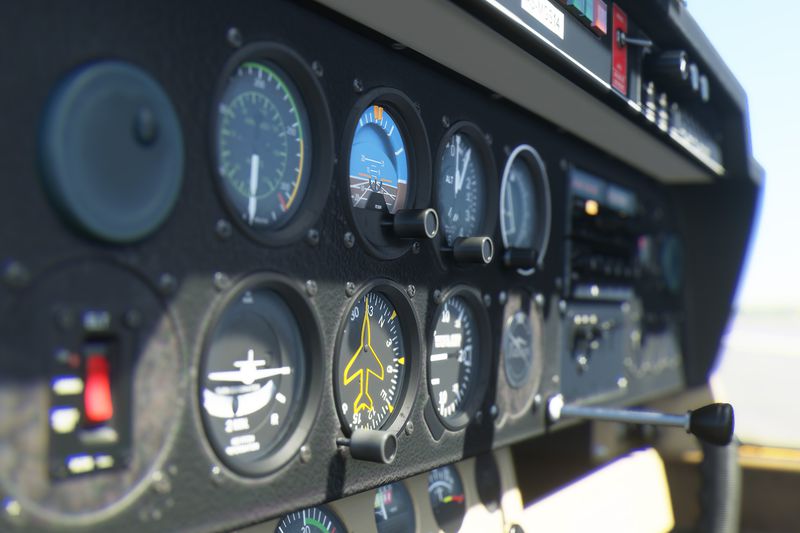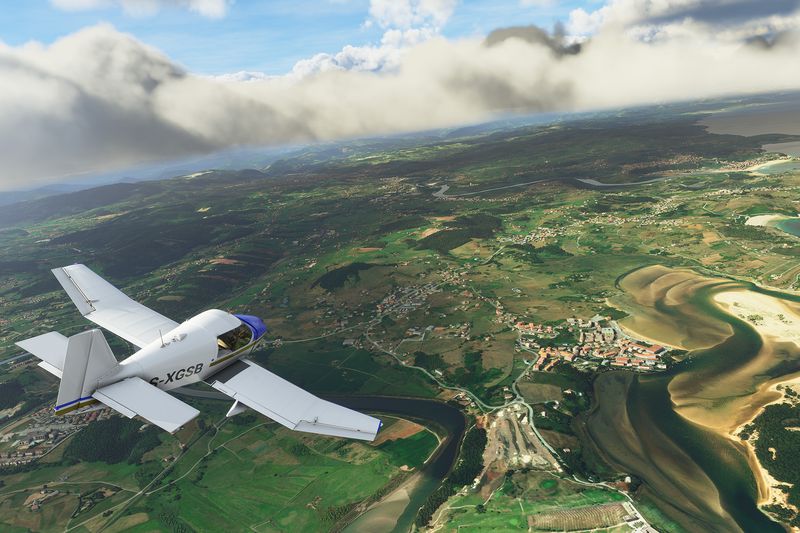Asobo Studio/Microsoft
We spent hours exploring the pre-alpha’s landscapes, streamed in from the cloud
Believe it or not, Windows isn’t Microsoft’s longest-running franchise. Neither is Office. It’s Microsoft Flight Simulator, a game that has roots that go all the way back to 1979. And, for the last few years at least, I was pretty sure that franchise was dead.
Microsoft Flight Simulator X was released over a decade ago, way back in 2006. That’s the same year as Gears of War and The Elder Scrolls 4: Oblivion, both titles launched at the beginning of the last console generation. But, Microsoft surprised everyone at this year’s E3 by announcing a brand-new version of the classic, simply titled Microsoft Flight Simulator. The final product is due out some time in 2020 for both Windows PC and Xbox One.
Earlier this month I traveled to the Pacific Northwest for a hands-on demonstration of an early version of the game. This was not your average demo day, however. Not only did Microsoft let me loose inside the game to fly a single-engine plane anywhere in the world, I also flew a real Cessna 172 over Seattle. The experience — flying a virtual plane and a real one back-to-back in the exact same airspace — proved to me the power and accuracy of the technology powering Microsoft Flight Simulator.
But Microsoft Flight Simulator is far from perfect. Its new approach to creating in-game assets, using data drawn from Bing Maps and Microsoft’s Azure cloud services, represents a unique technological challenge. It’s a remarkably ambitious project, and the team behind it still has a long way to travel.

Asobo Studio/Microsoft
Powered by Bing
When Microsoft Flight Simulator launches some time in 2020, it will give its users access to the entire planet. Just spin the globe on an X-COM-style world map, zoom into the airport that you’d like to start at, and you’re ready to go.
Assets will not only include all of our planet’s 197 million square miles of land and water, but more than 2 million cities and over 40,000 individual airports. To achieve this, developers at Asobo Studio are tapping directly into Microsoft’s Bing Maps dataset. Flight Simulator will draw from two of the service’s three available petabytes of geographical information. That includes satellite imagery and 3D photogrammetry data, with some resolutions down to just three centimeters.
The results are stunning. New York City looks nearly indistinguishable from the real place. Flying into Chicago’s O’Hare Airport, passing the skyline and making the big, left-hand turn on final approach is a trip I’ve made dozens of times over the years. It looks incredible, especially at night with thousands of lights — each with a different and accurate color temperature — winking down below. But those kinds of high-quality assets come at a cost.
Last week, we learned that The Last of Us Part 2 would ship on two Blu-ray discs. A single copy of Microsoft Flight Simulator would need 20,000 of them. So, instead of installing the game off disc, or even downloading a large portion of it as part of the initial installation, consumers will stream in assets while they play.

Microsoft
Developers say they’re working on a way to pre-load certain areas of the world ahead of time, to enhance the experience for those with slower connections and enable offline play. But, during the presentation last week, neither Asobo nor Microsoft pulled any punches. For most users, having a faster internet connection will make the terrain look a lot better, especially when it comes to 4K resolutions.
Despite the complexity of its asset pipeline, I can’t stress enough how remarkable the game looks.
Taking off from Renton Municipal Airport in-game, doing a touch-and-go at Snohomish County Airport, and then flying along the Seattle coastline, the experience was remarkably similar both in-game and out. At an altitude of 1,500 feet, the terrain looks almost identical. It’s as much a testament to modern satellite technology as it is the game itself.
But Microsoft and Asobo aren’t limiting themselves to making pretty terrain. They’re also working with aircraft manufacturers, including Cessna and Robin Aircraft, to make Microsoft Flight Simulator’s virtual planes as authentic as possible. Each plane will have fully interactive instrumentation and sophisticated flight modeling. It’s all thanks to unprecedented cooperation from aircraft manufacturers. That includes receiving access to the computer aided drafting (CAD) files used to manufacture the actual planes themselves, and getting virtual air time with experienced test pilots.
But the real magic of Microsoft Flight Simulator is in the environmental details.

Asobo Studio/Microsoft
Rainbow connection
Microsoft Flight Simulator features live weather pulled directly from Bing. That means pilots of every skill level will be able to take to the skies in the same kind of weather conditions going on outside their window in the real world. I’m not saying that individual clouds are being mapped from live video feeds, but the game uses things like live wind speed and direction, humidity, precipitation, and other factors to feed data into a simulation that’s constantly swirling in real-time. The results, say developers, are extremely realistic.
And yes, that realism extends to weather events like real-world hurricanes.
“I was on the phone with [Asobo Studios] the other day,” said Jorg Neumann, head of Microsoft Flight Simulator. “And it’s actually a bittersweet story. […] They said, ‘Jorg, here’s what we just did; We flew through Dorian in runtime.’ It was accurately there and it was moving up the east coast.
“I remember the comment [from the team] was, ‘We dove through it and we have some bugs because the eye wall isn’t exactly right.”
In this way, Microsoft Flight Simulator is attempting to simulate much more than flight. Things like rainbows, for instance, aren’t just stickers that get pasted onto the world. They’re something pilots can chase, putting themselves in just the right position around a simulated storm to witness one where it ought to be in real-life.

Asobo Studio/Microsoft.
The lighting and cloud systems are astonishing. The game engine is capable of simulating multiple volumetric cloud layers at the same time. Shadows are rendered through each of them in turn, but so are air and wind conditions. Turbulence isn’t something generated randomly to spice things up — it’s a result of currents over mountains and above forested areas on the ground.
That sort of attention to detail opens up the flight simulation experience in entirely new ways, creating the same kind of sophisticated aerial landscape that makes piloting a real-world aircraft such a challenge.
The simulation is so light, in fact, that you can switch between weather conditions mid-flight. I had the uncanny experience of flying through a bright sky, then moving a slider to make it cloudy, then rainy. The plane jerked in mid-air with every adjustment, but there was only the slightest hitch in the gameplay experience.

Asobo Studio/Microsoft
Fudging the data
This sort of approach to asset creation and weather simulation is a departure for the franchise. Previous iterations of Microsoft Flight Simulator were essentially hand-made, with artists placing and decorating entire landscapes. This time around, the team is taking a much more complex approach, feeding its tools real-world data, letting the software chew on it in real-time, and hoping something accurate pops out for the user on the other end.
But, like every other piece of software ever made, if you put garbage in you get garbage out. The challenge for developers right now is teaching the software to eat as much garbage as possible.
What I mean to say is that during my four-hour demo, I saw some really weird stuff.
Microsoft Flight Simulator will allow players to start a session at any airport in the world, or anywhere at all for that matter with their plane already in the air. So, one of the first places I visited was Egypt. I dropped onto the map over the Bent Pyramid, only to find an incredible 3D rendering captured, no doubt, with high-resolution photogrammetry. But, setting a course for the Giza pyramid complex on the horizon, I noticed something unusual on the ground below. Flying lower, I realized it was a deciduous forest. Developers hovering over my shoulder said that it must be the engine misinterpreting the texture of sand dunes, placing thousands of artificial, dust-colored trees that stretched on for miles.
Later, I dropped in over the South Rim of the Grand Canyon, doing my best impersonation of Will Smith in Independence Day. Under the direct sunlight of a blue sky the turbulence was astonishing. So too was the scenery. But as I banked left and drew up alongside a near-vertical cliff face the textures turned to mush. Captured from orbit, Bing’s satellite images simply don’t have any visual information for certain sections of that landscape. The result is a weird, banded smear along a rock face hundreds of feet tall.
I asked the developers if they planned to go back and fix the area by hand. They said no. Instead, the goal is to create software-based tools that can do the work automatically. The obvious implication is that as Bing Maps data gets better, so too will the look of Microsoft Flight Simulator.

Asobo Studio/Microsoft
A customized experience
The stated goal of Microsoft Flight Simulator isn’t just to reinvigorate the nearly 40-year-old franchise for a new generation. It’s to expand its audience, casting the net wider than ever before.
Part of that is multiplayer, of course, but developers aren’t quite clear on how that will be implemented just yet. Another factor is console compatibility. Previously, hardcore flight simulation has been the domain of PC owners. Making the game run on Xbox One, and offering it as part of the Xbox Game Pass, expands its audience significantly.
Developers tell me that accessibility is also an important factor. For that reason, Flight Simulator will be playable with a regular Xbox controller and the Xbox Adaptive Controller.
Microsoft is also adding hooks for the hardcore community. That includes the ability to create mods, like air traffic control and additional aircraft. But it also means making the game compatible with as many different peripherals as possible.
To that end, the team at Asobo Studio went and purchased every single flight stick and pedal set it could find on Amazon, and then gave a different solution to every developer. The maddening task of squashing bugs with certain brands of HOTAS or setting up button assignments on radically different devices is therefore spread around different members of the team. Whether or not certain sets will be “plug-and-play” though is still unknown.
Asobo even went so far as to build their own simulated cockpit right there in the office. They bought up an old DR400 fuselage, lugged it up the stairwell, and plopped it in the corner of their workspace. They’ve since had it wired up with working switches, and are using it as a test bed for the launch of the final product.
It all adds up to the impression that Microsoft is in this for the long haul.
“We’re not making a product,” Neumann told me later that day during a private interview. “We’re making a platform.”
read more at https://www.polygon.com/ by Charlie Hall
Gaming








